Scroll down for English
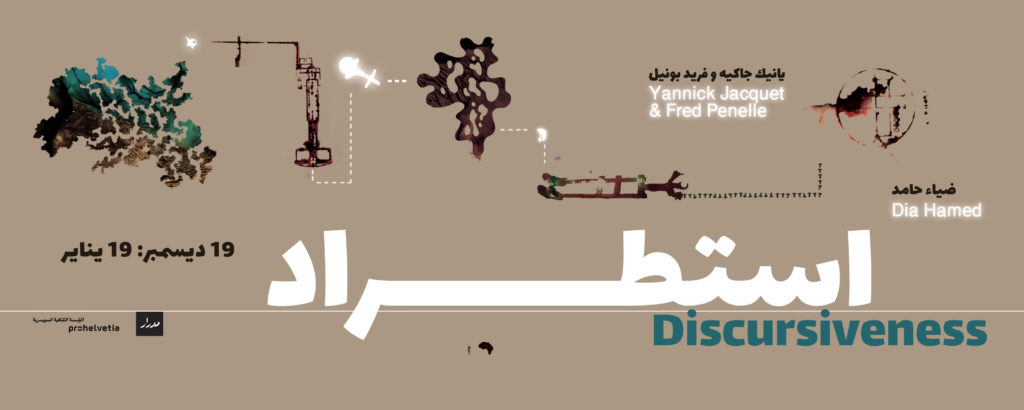
استطراد
يانِك جاكيه، فريد ﭘونيل
ضياء حامد
الافتتاح: الأثنين ۱۹ ديسمبر ۲۰۱٦، ٧ مساءً
يستمر المعرض حتى ۱۹ يناير ۲۰۱٧
يومياً من الساعة الثالثة حتى التاسعة مساءً، عدا الجمعة
مدرار للفن المعاصر
العنوان: ٧ جمال الدين أبو المحاسن، جاردنة سيتي، الدور الأول، شقة ٤
.
يقترح معرض استطراد التماثل النظري في أعمال كل من الفنانين يانِك جاكيه، فريد ﭘونيل وضياء حامد. حيث يتشعب الحوار بين أشكال الإبداع الرقمي من جهة، والإبداع في هيئته الواقعية الملموسة من جهة أخرى. ينعطف مسار إنتاج تلك الأعمال عند عدة محطات ووسائط مثل الطباعة والنحت والصور الرقمية. وبشغفهم للضوء والظلال، يحاول الفنانين تدعيم إستشعار المشاهد للحركة بالمادة المصورة، في مقابل إدراك السكون بالمادة المشكلة. كما يقاطعون بحسن النية السياق المستطرد للمحتوى النظري في الأعمال بأسلوب الإبهار الغامر للمحتوى البصري. يشير كل من جاكيه وﭘونيل إلى البث كمفهوم، من خلال تقنية الحفر والتكنولوجيا الكلاسيكية والتطبيقات الرقمية. في حين يتأرجح حامد بشكل إجرائي خلال المهارة الحرفية والاصطناع الآلي. يقحم نفسه في جدل مطول حول الأدوات واللغات والتقنيات الخاصة بالإبداع، في محاولة يائسة لإدراك كيفية خلق “الأشياء”.
تأتي الأعمال: ميكانيكا مستطردة، تضاريس ولزوجة بعناصر الإضاءة والحركة كوسيلة لإحياء السكون بالمجسمات المعروضة. يتلاشى الزمن، فيتردد الصدى عبر القطع المعروضة. حينما تتسامى المواد الخام إلى آليات مرئية وقابلة للتمييز، يتمكن يانِك وفريد وضياء من المناظرة عبر قاعات العرض بمدرار.
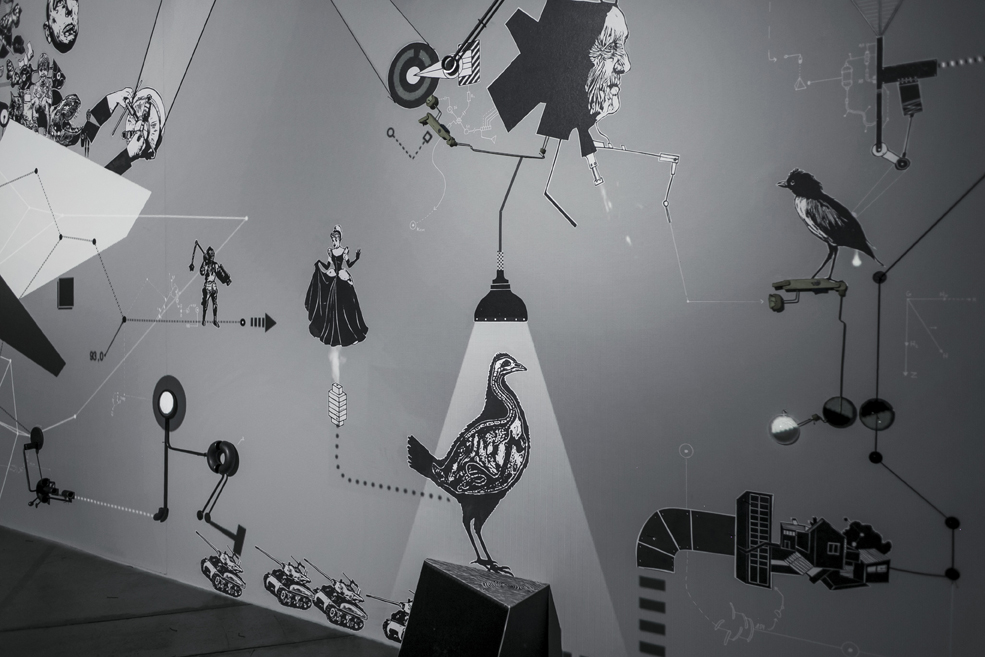
ميكانيكا مستطردة
يانِك جاكيه، فريد ﭘونيل
يقدم لنا كُلاً من فْريد ﭘونيل ويانِك ﭽاكيه وقفة واستراحة وفرصة لإلتقاط الأنفاس من عجلة مرور الوقت التى تزداد سرعتها يوماً عن يوم. تمتد آلية غريبة عبر الجدار تسكنها العديد من كائنات الكايميرا الغامضة التى تبدو مألوفة على الرغم من ذلك. هل هذه تجربة معملية أم خُطة لشَبَكَة مستقبلية؟ بُنيَّتْ هذه الآلية بدقة شديدة على شكل ساعة متقنة حيث تَتَتَّبَّعْ الإتصالات والطُرُق الزائفة بحق وبرامج الرحلات المتكررة وتَحُثُ على الهرب وتدعو إلى الحلم. يبدو السرد متفككاً كسيناريو فيلم يحتوى على الآلاف من القصص وكل الجهود المبذولة تهدف إلى التضليل والإلتفات والمُضىّ قُدُماً… يبدو الوقت ممزقاً ومتحللاً ومفقوداً، وعلى الرغم من ذلك يشير كل شئ إليه. ميكانيكا مستطردة هى مثل قوسان يقعا بين عصران مختلفان: عصر جوتينبِرج وعصر البيانات الكبيرة. يُطَّوِّعْ هذا التجهيز فى الفراغ القرون الزمنية ويجمعها سوياً ويُقَّلِّصُ الوقت ويُكثفهُ عن طريق المقارنة بين أقدم أشكال اعادة انتاج الصور (الحفر على الخشب) وأحدث التقنيات الرقمية المستخدمة.
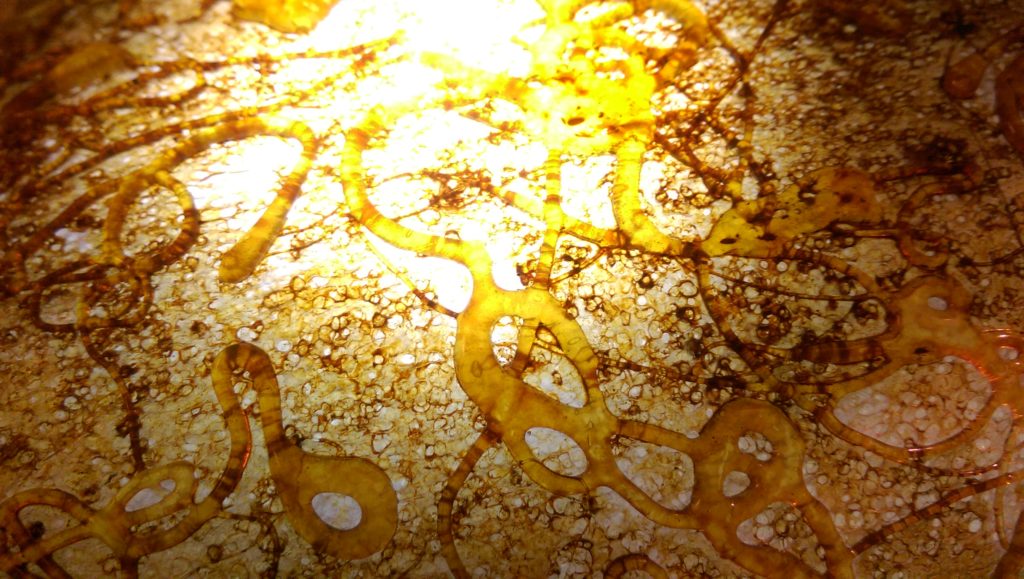
.
تضاريس ولزوجة
ضياء حامد
في قراءة لتطور وسائل التواصل البصري للوضع الحاضر، نلاحظ حالة عامة من التوجه نحو المحتوى ثلاثي الأبعاد، سواء من خلال تعديل مسطحات العرض أو النشر المكثف لأدوات الواقع الإفتراضي. يأتي هذا كوسيلة لتحسين سبل تفاعل المستخدم مع المحيط المعلوماتي وابهاره بعلاقة جديدة مع الأدوات وسهولة التحكم بها. تساهم هذه الموجة من التطور في تعميم و إتاحة آليات الإبداع ثلاثي الأبعاد. ربما يحتاج هذا التوجه إلى غزارة من المنتجات البصرية المستخدمة لتلك التقنيات. فيتم تحفيز الفنانين والمصممين كما غير المتخصصين للإنتاج هذا النوع من الوسائط، عن طريق تبسيط الأدوات والبرمجيات اللازمة. في هذا النحو، يطرح تساؤل حول مدى تسطيح العلاقة بين المبدع بهذا المجال وأساسيات إدراك طريقة خلق البرمجيات لتلك الخامات والمنظومات التي تحاكي الواقع لدرجة مبهرة.
يحاول ضياء حامد تدقيق النظر إلى كيفية وجود الخامات الطبيعية بالمحيط الإدراكي، العناصر والقوى التي تشكل الملامس التي نعرفها. كيف تتهيئ العشوائية في أنماط ومنظومات للسطوح. كما يسعى للعثور على تشابه بين آليات تكون المواد في الواقع وآليات إعادة خلق أشباه نفس المواد من خلال معادلات حسابية وخوارزميات لمحاكاة أشكال الطبيعة.
يمكننا إدراك الجماليات الكامنة في الهيئات العشوائية حينما ترتقي لحالة المنظومة ذات النمط المتجانس. عندها يستطيع الإنسان رؤية ماهية الشئ، سواء مسطح حجري، مائي أو أي من أنسجة الكائنات الحية. يمكن للعشوائية أن ترتقي للنمط المتجانس فقط عندما تتأثر بعوامل محيطة، مثل الجاذبية والضغط والحرارة بما يساهم في تشكل نسق الجزيئات. كما تستطيع الخوارزميات الحسابية إنتاج أنماط مماثلة فقط من خلال التعديل في المقدار الرقمي بالشكل المناسب للنمط المرجو محاكاته. بالنظر إلى الهيئات الصلبة والهيئات السائلة كأمثلة متضادة لطبيعة المواد، نجد أنه ثمة قانون أو عنصر موحد للتشكل، ألا وهو: التقلب الغير منتظم للبيانات (والبيانات في هذا السياق ما هي إلا موقع ودرجة سطوع “البكسل” على شاشة عرض مثلاً أو موقع و درجة وضوح الجزيئات في عالمنا الملموس)
من خلال الأعمال الفنية المجسمة “تضاريس ولزوجة” يمارس ضياء حامد الأسلوب التجريدي بشكل مباشر. كما تمر مراحل إنتاج تلك الأعمال في تعددية للوسائط والأدوات، مثل التصنيع المبرمج الآلي في مواجهة الحرفة اليدوية والعكس. هذا التحول المتكرر والتذبذب في طرق التشكيل يأتي كظاهرة لتأثره بحالة التغير المتفاوت، التي هي أساس تكوين المنظومات العشوائية. يعتمد محتوى المواد المعروضة بالأعمال على دمج صور متحركة لمجموعة من الملامس الطبيعية مع أشباهها المخلقة من العمليات الحسابية. وتحدث حالة المزج من خلال الضوء كمكون أساسي لصبغ المجسمات النحتية.
يعتمد العمل “تضاريس” على تقنية العرض الضوئي المتراكب فوق أسطح طبوغرافية. ويعتني بدور كل من: جيورجي فوروني، كين مسجراف وكيم بيرلن في إكتشاف الخوارزميات الحسابية الأولية لخلق منظومات العشوائية المصطنعة، مما كان له الأثر الكبير في تطور البرمجيات الإبداعية المحاكية للأشكال والملامس الصلبة. كما يقارن العمل لزوجة تسجيلات مجهرية لتفاعلات الصابون في مقابل مؤثرات بصرية مشابهة، تعتمد على خوارزميات آلان تورينج وستيفن وورلي المحاكية للأشكال السائلة. ويأتي مسمى العمل لزوجة كقياس لدرجة الكثافة أو الميوعة للمواد السائلة.
عن الفنانين
يانِك ﭽاكيه (سويسرا/ فرنسا)
وُّلِدَ يانيك ﭽاكيه فى ﭽينيف عام ۱۹۸۰ ويقيم ويعمل فى بروكسل.
عُرضت أعمال ﭽاكيه (أعمال بلاستيكية ووسائط متعددة) فى العديد من الفَعاليات الفنية المعاصرة والمتاحف والمعارض فى باريس وموسكو وطوكيو وبروكسل ومونتريال وتايوان، كما حصل على “جائزة تِك” فى “أسبوع ميلان للتصميمات” والجائزة المُجَّمَّعة فى “بروسيلز سْليك آرت فير” (معرض الفن الأملس ببروكسل) وهو أحد مؤسسو علامة “أنتيﭬيﭽى” (Antivj) البصرية. قاد تعاون ﭽاكيه مع مختلف الفنانين إلى الشروع فى عمله الحالى قيد التنفيذ “الميكانيكية الإستطرادية” الذى شارك فى اعداده مصمم المطبوعات فْريد ﭘونيل وهو مشروع يُعرَض بشكل دائم فى كلٍ من أوروبا وآسيا.
www.legoman.net
www.antivj.com
فْريد ﭘونيل
“فى أقل من عشرة سنوات قدم فريدريك ﭘونيل الذى ولد فى بروكسل عام ۱۹٧۳ والحائز على جائزة “المسابقة الفنية” فى نهاية عام ۲۰۰٧ إلى فن الحفر والطباعة دفقة مفاجئة من الطاقة من خلال استخدامه الجديد لهذا الفن بطريقة أصيلة وخبيثة ومضحكة بقدر ما هى جدية أيضاً. يقدم التجهيز فى الفراغ فى كل معرض مجموعة من الشخصيات والأشياء مثل العصور والأزمنة والرسم واللوحات والأسود واللون والصور القديمة وأى أشياء أخرى تمتزج على الجدران إما بشكل هزلى أو جاد لتخبرنا بآلاف من القصص المتشابكة التى يُدركها كل شخص طبقاً لمخيلته الخاصة ولما عاشه ومر به وكذا لأحلامه ومخاوفه. يقدم هذا التجهيز من خلال مجموعة غير متجانسة إلا أنها متماسكة بشكل مدهش فى غرابتها الخطية التى تبدو كإفريز يربط الأساطير الشخصية التى تجمع الصور المعروفة لدى الجميع صورة للعالم بشكل مثير للدهشة ومألوفاً فى الوقت ذاته. يعطى دائماً هذا الترتيب اللعوب المُسلى والمبتكر والذى يصبح مهَدِداً ومأسوياً فى هيئته فى بعض الأحيان انطباعاً بأنه قد يطلق العنان لنفسه وكأنه عرض كوميدى واسع يقدمه ممثلون يشبهوننا بشكلاً غريب. هل من الممكن أن نكون مشاركين فى هذا العرض دون وعى منا؟ يبدو مقنعاً للغاية وملهماً.” (سى إل)
(“لا ليبر بيلﭽيك” –”بيلجيكا الحُرة”- فى ۱٦-۰۱-۲۰۰۸)
تصميم المطبوعات: طارق راضي
ترجمة: سارة علام
مساعد تقني: ميدو صادق
المعرض بتنظيم مدرار للفن المعاصر وبدعم من بروهيلفتسيا – المؤسسة الثقافية السويسرية
![]()
.
Discursiveness
Yannick Jacquet and Fred Penelle
Dia Hamed
Opening: Monday 19 December 2016, 7pm
Exhibition runs till 19 January 2017
Daily from 3pm until 9pm, except Friday
Medrar for Contemporary Art
Address: 7 Gamal El Din Abou El Mahasen, 1st floor, Apt 4, Garden City
The exhibition Discursiveness suggests analogy within the works of Yannick Jacquet, Fred Penelle and Dia Hamed as instances of an expansive communication between tactile ( and digital forms of practice. Their works meander across multiple stages and mediums like printmaking, sculpture and digital media. With a passion for luminance and shades, their works not only accentuate the stability of materials in static objects, but also strengthens the viewer’s senses towards the motion represented in a set of blinking pixels. In an immersive non-discursive setup, Jacquet and Penelle address transmission in old school wood engraving, vintage technologies and digital masking, while Hamed procedurally shuffles through skill, tool and automation. He tries to jabber in a conversation in which one can lose track of how “things” are made, lingering over the intermediate processes, languages and technologies of creation.
Mécaniques Discursives,Terrain and Viscosity, digitally animate and illuminate physical forms. Time deconstruction allow for invoking reverberation among the exhibited pieces. Transcending of substance towards observable mechanisms is how Yannick, Fred and Dia echo within the walls of Medrar’s exhibition space.
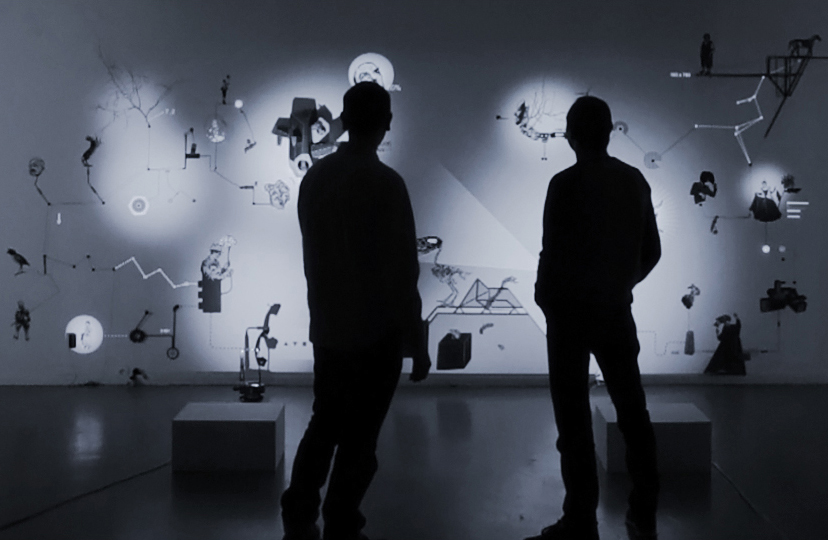
Mécaniques Discursives
Installation by Yannick Jacquet and Fred Penelle
While the passage of time seems to accelerate every day, Fred Penelle and Yannick Jacquet offer a pause, a suspension, a breath. A strange mechanism stretches across the wall, populated with shadowy chimeras. They are mysterious and yet somehow familiar. Is this a laboratory experiment or the plan for a future network? Minutely constructed like a fine clock, it traces connections, routes, genuinely-false, looping itineraries, inviting escape, inviting dreams. The narrative is deconstructed like a thousand-storied film script. Every effort is made to lead astray, to turn around, to forge ahead. Time is shredded, decomposed, lost…and yet everything references it. Mécaniques Discursives is like a parenthesis between two epochs: Gutenberg’s and Big Data’s. By contrasting the oldest form of image reproduction (woodcutting) with the most recent digital technologies, the installation straddles centuries and contracts time.
.
.
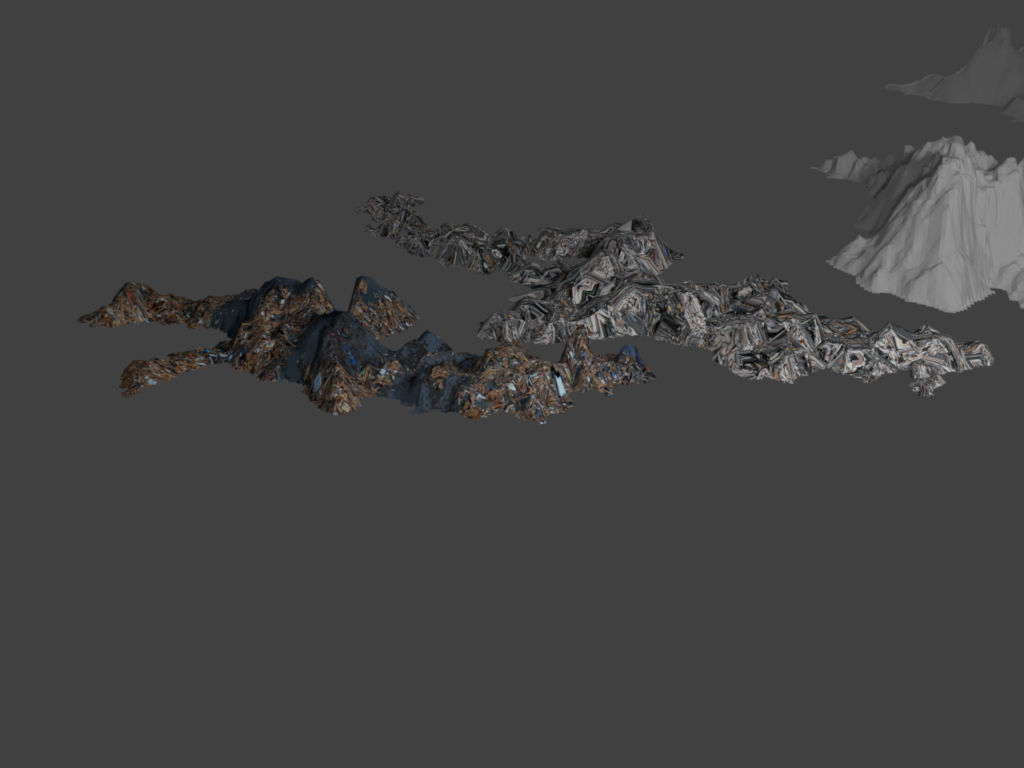
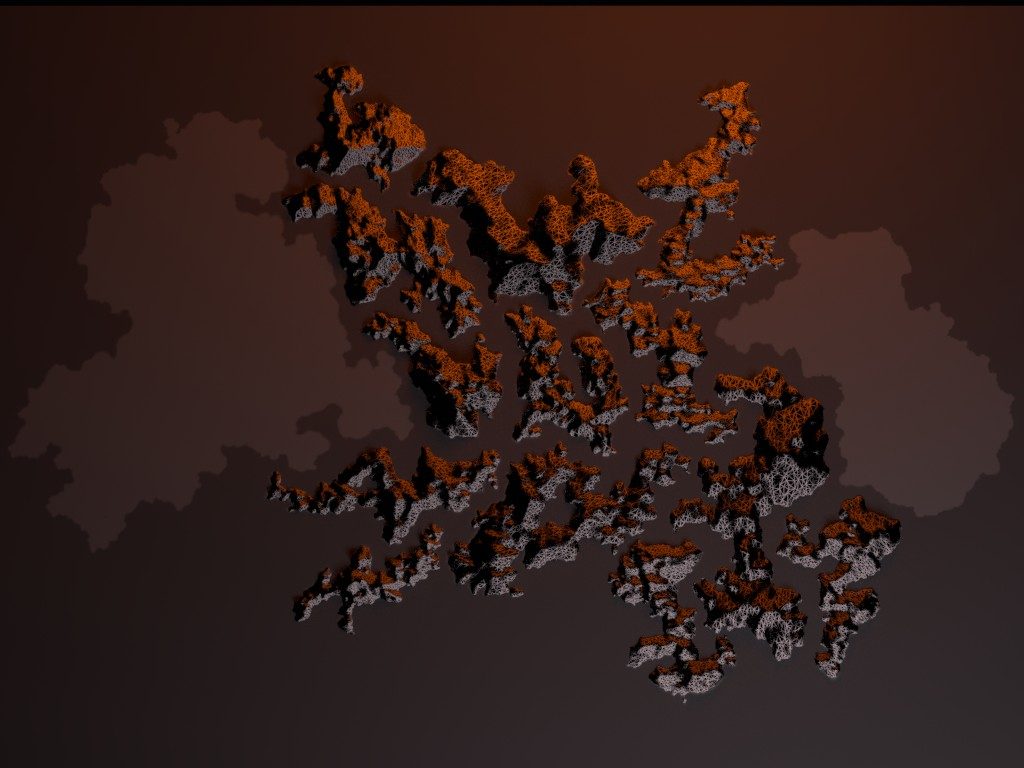
Terrain, Viscosity
Two installations by Dia Hamed
We’re currently witnessing an excessive development in the field of augmented vision. Various platforms are asking us to look around in 360º. A market boost in virtual reality products promotes a new experience of perceiving the surrounding environments, using additional information and intuitive controls. In order to supply enough media for such influx, big effort is now exerted in offering artists, designers and “ordinary people” accessibility to create and manipulate three dimensional worlds. Yet the act of simplifying 3D software interfaces contributes to our disconnection from the inherent complexity of how such tools are able to mimic surfaces and shades of our physical reality.
Dia Hamed draws back to the very essence of matter formation, trying to find resonance in the evolution of appearance from states of absolute randomness to patterns of natural systems, as well as in the development of computer algorithms from mathematical turbulence functions to spectacular simulations of natural textures. Random systems gain aesthetic appeal when they become manifest in pattern order. Patterns can only develop when randomness is perturbed by external forces, whether natural as of energy (gravity, pressure and temperature applied to particles) or artificial as of parameter adjustments (function dimensions and random seed number applied to pixels). Solid structures and fluid dynamics seem to share the same governing rule: the irregularity of data fluctuation, where data in this sense define the position and brightness of pixels on screen, same way as it does to particles in the real world.
Hamed transforms the medium from one state to another, between automated tools and the artist’s manual intervention. The symptom of Oscillation in his compositional process echos the irregular variations in which matter originates. Terrain and Viscosity are exercises in abstraction. Using light as the animating component of presentation, the visuals combine filmed natural textures with their peer synthetic representation in pixels, and converge over the surface of physical sculptures.
Terrain involves digital projection mapping on a raised-relief map. It highlights the contributions of Georgy Voronoi, Ken Musgrave and Kim Perlin to the world of computer graphics, specifically their discoveries in noise algorithms to simulate solid nature forms. Viscosity compares microscopic footage of soap reactions to its code generated simulation, within a sculpture made out of materials that were once in a liquid state. Viscosity features Alan Turing’s reaction diffusion systems and Steven Worley’s cell noise to simulate liquid forms.
About the artists
Yannick Jacquet
Born in Geneva in 1980, Yannick Jacquet lives and works in Brussels.
Media & plastic, his work was presented at Contemporary art events, in museums, galleries, in Paris, Moscow, Tokyo, Brussels, Montreal and Taiwan. He has received the Tech Award price at the Milan Design Week, and the collector’s price at Brussels Slick Art Fair.
He is one of the founders of the Antivj visual label. His regular collaborations with different artists lead him to the Mécaniques Discursives work-in-progress, developed with the printmaker Fred Penelle, a project that is frequently exhibited in Europe and Asia.
www.legoman.net
www.antivj.com
Fred Penelle
“In just under ten years, Frédéric Penelle (Brussels 1973), winner of the Art contest prize at the end of 2007, has given engraving a sudden burst of energy through his novel use of it in a way that is fundamentally original, malicious and as funny as it is serious.The installation of each exhibition places on a wall a swarm of characters and objects which mix, either play- fully or seriously, times, epochs, drawing, paining, black, colour, old images and whatever else besides, to tell, not one, but a thousand tangled tales in which each will recognise his own according to his imagination, what he has lived through, his dreams or concerns.In a heterogeneous set astonishingly coherent in its linear weirdness like a frieze, starting from a personal my- thology that brings together images known to all it holds up a portrait of the world that is surprising yet familiar at the same time. And this arrangement that is playful, amusing, inventive, sometimes threatening and also tragic in its device, constantly gives the impression that it might set itself in motion as if it was a vast comedy put on by actors who bear a strange resemblance to us. Might it be possible that we are taking part unawares? Very inspired and convincing.” (C.L.)
(la libre belgique 16/01/08)
www.penelle.be
Dia Hamed
An interdisciplinary artist based in Cairo, born 1982. Co-founder of Medrar for contemporary art and it’s former director of projects 2008-14.
Throughout his course of progression, he initiated and took part in a set of programs that involve Craft, Creative Coding, Puppetry, Video Jockeying, Social/Physical/Visual Theater and lately worked on a Rimini Protokoll documentary theater production 2009-12. He also inaugurated and managed the OpenLab Egypt project 2009-14. Currently working on archiving the past 7 editions of the Cairo Video festival and creating it’s accessible platform for artists and researchers.
Graphic design: Tarek Rady
Traslation: Sara Allam
Techical support: Mido Sadek
Exhibition is curated by Medrar and supported by Pro Helvetia – Swiss Arts Council